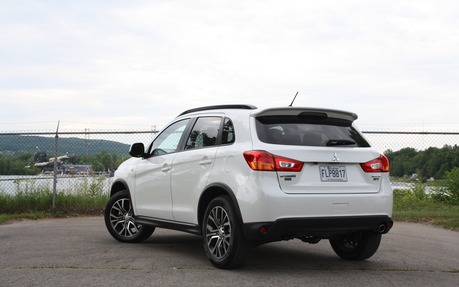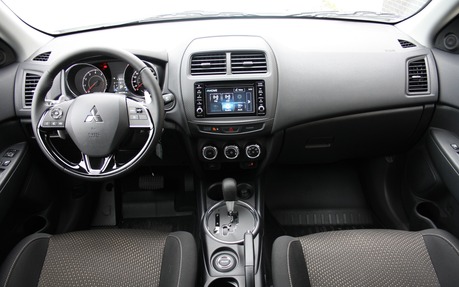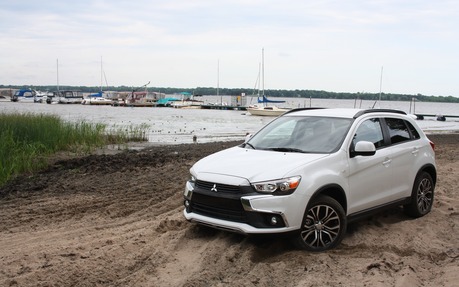2016 Mitsubishi RVR: Reason Over Passion
It’s easy to fall in love with a subcompact SUV, because they’re fuel efficient, they’re fairly roomy and most of them offer peace of mind with an all-wheel drivetrain to confront our harsh winters. More and more Canadians are choosing these urban trucklets, and the segment should continue to grow in the next few years as more models will hit the market.
The Honda HR-V, Mazda CX-3, Jeep Renegade and Fiat 500X are but just a few models that have recently been introduced, and they’ll soon have to face the upcoming Toyota C-HR as well as a redesigned Jeep Compass. However, let’s not forget the veterans, the catalysts of the small SUV category such as the Mitsubishi RVR.
- Also: 2016 Mitsubishi Outlander: A Very Decent Proposal
- Also: Discovering The Mitsubishi Outlander PHEV
It’s been around since 2011 in its current form, although some cosmetic changes were performed for the 2016 model year. Nothing major, but little tweaks to recognize a new RVR from older ones. The front grille has been reworked to boast the brand’s Dynamic Shield design theme which has also been grafted to the bigger Outlander.
Some upscale touches have also been added to the exterior in order to give the RVR more visual flair, such as power-folding mirrors with integrated LED turn signals, wheel lip mouldings and new paint colours. The RVR SE Limited Edition AWC variant we tested also included a set of spiffy 18-inch alloy wheels.
Like the Renegade and unlike the low-slung CX-3, the 2016 Mitsubishi RVR has a fairly high roofline, and that’s because ground clearance is one of the highest in its class, along with the aforementioned Jeep and the Subaru Crosstrek. The high-riding body gives it a more rugged look—despite being a “cute-ute”—and enhances its ability to head off the beaten path.

The All-Wheel Control system can be manually activated with the help of a console-mounted button, and favours the front wheels under normal driving when in Auto mode. However, when the going gets rough, the driver can choose the Lock feature that gives the system a fixed 50:50 front/rear split. Quite handy for getting out of sticky or slippery situations, and one of the most capable systems in its segment.
Base ES and SE trim levels get a 2.0-litre four-cylinder engine, which develops 148 horsepower and 145 lb.-ft. of torque. It’s generally fine for the daily commute, and its output is in line with many of its competitors’. A five-speed manual transmission is standard, while a continuously variable automatic is optional.
A couple of years ago, the automaker added a 2.4-litre engine, which currently appears in the SE Limited Edition and GT models, which both include all-wheel drive and the CVT automatic. The bigger four develops 168 hp and 167 lb.-ft. of torque, making performance a little more interesting. The sacrifice in fuel consumption is about half a litre every 100 km, so it’s not that bad. Over the course of our test, we averaged a pretty decent 9.6 L/100 km.
On the downside, the automatic transmission isn’t a very enthusiastic partner to the engine, the latter which can get a little noisy at wide-open throttle. The company did tweak the CVT’s programming not too long ago, and launches are a little more spirited than they used to be in earlier versions of the RVR. There’s still room for improvement, but we think most consumers will be satisfied with the SUV’s powertrains. In addition, we won’t find any high-tech wizardry such as direct injection and turbocharging here, so long-term reliability shouldn’t be a concern.
On the road, the RVR feels solid, although the 18-inch tires thump quite a bit on rough pavement. The little SUV’s handling is more enjoyable than the ones of the Jeep Compass/Patriot brothers and the Chevrolet Trax, although it’s not as refined as some of the newer players in the segment such as the Mazda CX-3. The RVR’s turning circle diameter is among the best of its class, definitely an advantage in the shopping mall parking lot.
The 2016 Mitsubishi RVR’s cockpit design likely won’t amaze anyone, but doesn’t feel cheap either. The controls are straightforward, although the infotainment system touchscreen isn’t the most enjoyable to use, with its small button zones, and the majority of its on-screen functions are locked out when the vehicle is in motion, which is a little frustrating.

On the other hand, the driving position is fine and the seats are both supportive and comfortable. The back seat has high cushions, so occupants sit straight up and benefit from a decent amount of leg and headroom. Cargo space is average in its segment, and when the rear seatbacks are folded down, the load floor is flat and very usable.
Base price is set at $19,995 before freight and delivery charges, while a loaded RVR GT is listed at more than $33K—a bit much for an urban SUV. We think the sweet spot is the SE AWC with the CVT, which retails for $26,298. For an extra $1,200, the Limited Edition version is upgraded with bigger wheels, black painted roof rails, a rear spoiler, a different seat fabric, climate control, some minor trim changes and the bigger engine.
The 2016 Mitsubishi RVR isn’t the most affordable of its category, it isn’t the most exciting to drive and isn’t the most technologically advanced, either. However, this Japanese brand sells vehicles for consumers who prefer keeping them for the long term, and has the best warranty with 10-year or 160,000-km powertrain coverage. Unlike some its rivals, we might not be lovestruck during a test drive around the dealership’s block, but the RVR’s virtues grow on you over time.
| Test drive report | |
| Test model | 2016 Mitsubishi RVR |
|---|---|
| Trim level | Limited |
| Price range | $19,995 – $33,198 |
| Price as tested | 27 498 $ |
| Warranty (basic) | 5 years/100,000 km |
| Warranty (powertrain) | 10 years/160,000 km |
| Fuel economy (city/highway/observed) | 10,5 / 8,6 / 9,6 L/100km |
| Options | N/A |
| Competitive models | Buick Encore, Chevrolet Trax, Fiat 500X, Honda HR-V, Jeep Compass, Jeep Patriot, Jeep Renegade, Kia Soul, Mazda CX-3, Nissan JUKE |
| Strong points |
|
| Weak points |
|
| Editor's rating | |
| Fuel economy | Not bad, although the RVR isn’t the most efficient in its category |
| Comfort | Solid ride, tarnished a little by the stiffness of the 18-inch tires on uplevel trims |
| Performance | Fine under normal driving, but the CVT automatic doesn’t like to be rushed |
| Infotainment | Decent sound output, but the touchscreen looks and reacts as if it’s yesterday’s technology |
| Driving | Not too sporty, but comfortable and a very capable all-wheel drivetrain for winter |
| Overall | Better than the sum of its parts, the RVR is more enjoyable in a long-term relationship |
